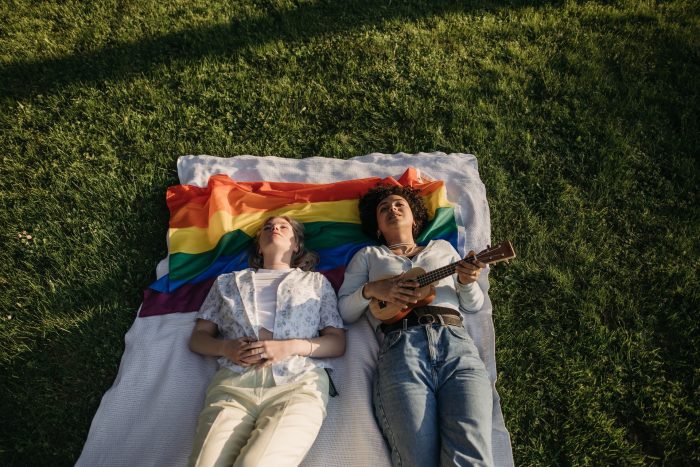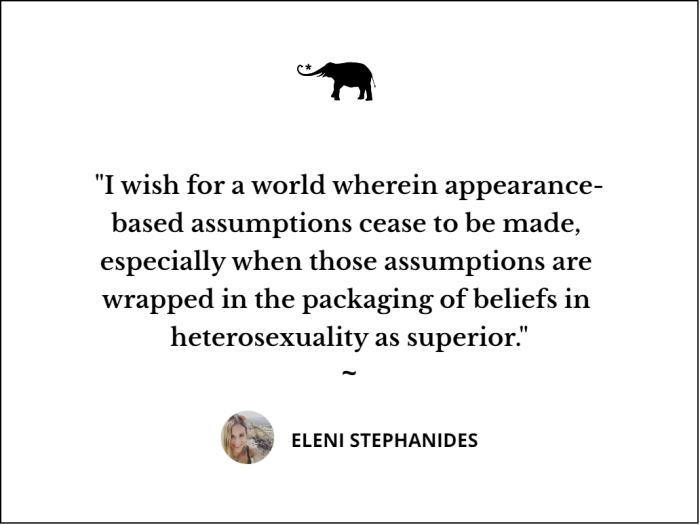The smell of empanadas wafted through the air as I powered briskly up Calle José Ellauri on my way to the barbershop.
Accompanied by the sound of horse hooves, clomping against the adjacent cobblestone street, I passed by a storefront that said “Panaderia,” another that said “Fotocopias.” To my left and right, little houses resembling Turkish delights boasted colorful exteriors.
Just a few blocks down, the waves of the Rio de la Plata broke against a sandy shore, where uruguayos, young and old, gathered to drink mate or kick a soccer ball.
“Hola,” the barber greeted me as I walked in. “Que tipo de corte quieres hoy?” (“Hi. What kind of cut are you looking for today?”)
“Lo más corto posible,” (“As short as possible”) I responded.
The barber nodded—replying with “bueno” (“okay”).
Then, after sitting me down and covering me with an apron, he began snipping away.
Becoming Acquainted with Heteronormativity
It was August 2013, and I’d been living in Montevideo, Uruguay, for seven months now—but heteronormativity had long been a surrounding presence in my life, as it is for all of us members of the LGBTQ+ family.
The first time I became viscerally aware of the concept, I was a newly out freshman at a frat party in my college town of Davis. The year was 2008, and Flo Rida and Lady Gaga blared from the speakers as my dorm mates and I queued up for “Jungle Juice” on a warm September night.
One frat brother handed us back our filled cups.
“What’s in it?” one friend yelled.
“Everything!” the brother serving her shouted back.
Another attempted (unsuccessfully) to balance red beer cups on my shoulders. All around, Elmo-red mustaches left by the Jungle Juice emblazoned the tanned faces of partygoers.
As was the case at most mainstream gatherings back then, an unspoken assumption of straightness permeated the air between party attendees. Cis guys went up to girls. Girls decided if they were into the bros who approached them. Hooking up happened. Numbers were exchanged. Livers took some hits.
In the years to come, heteronormativity continued to follow me from one situation to the next. It showed its face at a former job while sipping coffee with senior Latina ladies, who’d joke about bringing me back a husband from El Salvador.
It hung over the interaction when a guy down in Los Angeles asked me, “So did you come down here with friends, on your own, or with a man?”—as if those were the only three options.
Through my 20s, “do you have a boyfriend?” was a question posed by strangers as conversational icebreakers (as commonplace as “how’s your day going?”).
From college on, I found that even queer spaces weren’t immune to the heteronormativity’s influence. The number of times people seemed legitimately shocked when they found out I was gay (at a gay bar) was higher than I’d ever thought it would be.
Additionally, I was discovering that assumptions of heterosexuality made it more difficult to meet women to date. It often seemed like cis men were the sole demographic to pursue or express any interest in me (based off an incorrect assumption)—even at lesbian bars.
The Problem with This
Most of the time, hetero-presumptive comments aren’t fueled by any negative intent. The cumulative result of them, though, is that many days, we “passing queers” feel involuntarily cloaked in a robe of invisibility, with the onus on us to decide when and how to pull it off. As many LGBTQ+ people will tell you, heteronormativity turns coming out into a lifelong process.
In the weeks leading up to this day at the Uruguayan barbershop, a construction worker had yelled lewd things on the street.
A student had matter-of-factly stated, “You don’t look gay.”
A straight man at a lesbian club had jokingly questioned what I was doing there—“So did your gay friends drag you along like mine did?”—before asking me if I wanted to leave with him.
I’d googled “love” while compiling a lesson plan for my English students, and picture after picture showed young girls smiling into the faces of young boys.
Perhaps, my favorite: “Are you selling these for a friend?” a man had asked, gesturing to the lesbian romance novels I was selling at the Tristan Narvaja street market.
Wearied by these constant assumptions and ready for a change, I decided to change my look. I viewed cutting my hair as a way to reject my role as an unwitting sexualized pawn in our patriarchal system. It would do so by finally hinting, through my appearance, at an important and enduring aspect of my identity.
**Disclaimer: plenty of straight women opt for short hair, and I don’t mean to imply anything as simplistic as “short hair and gayness are synonymous.” In my case though, I was looking for a specifically more boyish, or gender-bending, cut.
Once the barber put down his scissors, I glanced at my reflection in the mirror. The cut was chic, cute, and stylish—but I wanted shorter. Less Emma Watson, more Taylor Lautner.
“Shorter,” (“Más corto”) I requested.
The barber snipped again—and when he paused once more, I asked for shorter still.
Finally, we arrived at a cut I was satisfied with—one that I deemed “sufficiently queer.”
How People’s Treatment of Me Changed
As I’d hoped it would thereafter, the cat-calling from men seemed to tone down. More women seemed to be showing interest in me. One, a waitress at the (mostly empty) neighborhood Irish pub I went to read at one night, continually came to top off my water glass and chat—sometimes, even when the cup was mostly full.
Another casually approached me outside of a lesbian club. This had never happened back when I had long hair (and by that point, I’d been to my share of gay spots). Still another woman found my Facebook profile and sent me a message inquiring about the beach yoga group I’d posted about in Couchsurfing.com. Though she never attended the group, we did end up dating thereafter.
“I wouldn’t have known if it hadn’t been for the short hair and your rainbow cover photo,” she later told me.
When I moved into a house with 10 native Uruguayans, one male housemate almost immediately began referring to me as “Torta” (the Uruguayan slang word for lesbian), even though I hadn’t told him I was gay.
No longer donning an appearance of conventional femininity, I noticed a difference in the way people were perceiving me. More seemed to begin regarding me as queer (or even, occasionally, a boy).
One day, for instance, the guy working at a local Internet café that I often frequented earnestly inquired:
“Puedo preguntarte donde conseguiste tu corte de pelo? (“Can I ask where you got your haircut?”) he said to me—“Porque yo quiero uno parecido” (“Because I want a similar one”).
On What it Means to “Look Gay”
Part of me believes that in this hetero world—whether it’s LGBTQ+ community we’re looking for, or just some kind of nod to remind us that we’re not alone— aesthetics of queerness are not only a helpful tool, but a means of self-expression that accurately conveys a lot of queer people’s personal style.
Many—particularly those who don’t feel they fit inside a neat box on the gender binary—find legitimate comfort in them. Their chosen aesthetics represent their authentic selves far more than a more “conventional” appearance ever did.
Physical markers set us apart from the straight masses. Adopting them is a way for us to find each other “out in the wild.”
As writer Jill Gutowitz put it, “Queer people have never been able to live their lives as freely and openly and spectacularly as straight people have. We’ve always had to find each other, in dark corners of gay bars, in back alleys, in niche Tumblr fandoms, to survive. It’s simply human nature to find those who are like you, to gravitate toward them, to stick together and find power in numbers.”
They can also be fun; I enjoy my nose piercing (which I’ve had since I was 21) and wearing the occasional plaid.
And yet it’s hard not to feel like they also perpetuate the (erroneous) idea that sexuality “looks” a certain way—when it doesn’t. Like meat-eaters, people with diabetes, and residents of Muncie, Indiana, we gays run the gamut when it comes to appearance. Not to mention this generalization—together with misogynistic attitudes—often comes at lesbians’ expense, in the form of micro-aggressions.
Take the following interaction I had with a guy at a party in my early 20s:
“You like girls? So you’re bi?” he asked.
“When did I say I was bi?” I replied.
“Well, you look more like a bi girl than a lesbian.”
“What does a bi girl look like?”
“Well, they’re hotter.”
“Why are lesbians less hot?”
“Well, because they don’t like guys.”
The Cumulative Effect of Microaggressions
As more time has passed and I’ve gotten older, my upset in response to these hetero-presumptive comments has cooled to minor annoyance. It’s become easier for me to laugh them off (especially that one man’s “Are you selling those lesbian books for a friend?” question (I just picture my buddy and me meeting in a dark alleyway, where she surreptitiously hands me the novels, along with the whispered promise of a 10 peso tip if I can manage to find a buyer).
There are far more serious forms of oppressions that affect members of our LGBTQ+ community in more serious and direct ways.
The comments I mentioned, while annoying, don’t necessarily impact our lives in any immediate or day-to-day sense, nor are they bona fide reflections of clear-cut misogynistic or homophobic characters on the part of whoever made them. They have much more to do with the culture that we all have been steeped in from birth—which is one that spreads its ideas onto us almost undetectably and imperceptibly, and without our consent.
In other words, I don’t blame the people who deliver the assumptions through their remarks. I blame compulsory heterosexuality, the system that trains them to think this way. Ultimately, I also know that what matters most is not how the world sees us, but who we know ourselves to really be.
Still, the comments are little cuts—constant subtle reminders of our lesser-than status as LGBTQ+ people. And the cuts can add up, especially without the cushioning presence of like-minded and like-hearted chosen queer family.
Adopting an appearance that doesn’t feel authentic to one’s self just to fend them off feels disingenuous. So why can’t the world just stop assuming?
A Post-Heteronormative World
I’d like to think we’re getting there, slowly. That one day queer femmes will stop hearing comments like “You’re Tindering girls? That’s hot,” while waiting in line for the bathroom. That when I’m out on a date with my girlfriend, men will stop hitting on one of us in front of the other. They’ll censor themselves when they feel the threesome question bubbling up in their throats, the same way one would cover their mouth when they’re about to burp.
I’d love it if a waitress at an Irish pub came to make repeated small talk under the guise of refilling my water glass, regardless of the way my hair is cut. I want the doctor who asks whether I’m on birth control to refrain from assuming that the reason I’m not is because my partner uses condoms. I want the equally viable possibility that pops into her head to be that maybe it’s because I don’t have heterosexual sex at all.
I wish for a world wherein appearance-based assumptions cease to be made, especially when those assumptions are wrapped in the packaging of beliefs in heterosexuality as superior.
Ideally, one day, part of the “college experience” will be that when a baby queer goes to a gathering, all genders will be equally likely to approach her. It will become second nature to ask women, “Do you have a partner?” instead of “Do you have a boyfriend?”
Maybe the more we calmly assert ourselves, the more the collective idea that gay people come in an identifiable package will evolve.
Perceptions change through exposure. They change through people being who they are—calmly, confidently, and with nothing to hide or defend.
From a them.us article: “I look queer because I am queer, and thus, the definition of what is queer-looking is defined by my existence, not the other way around.”
My hope is that after absorbing it deep into their collective psyche, more of the world will embrace this declaration. But even if this doesn’t happen, we don’t have to wait on them to live out our truths as queer people.
You can find me at the vegan cat café. I’ll have my Lex app open.
~
Please consider Boosting our authors’ articles in their first week to help them win Elephant’s Ecosystem so they can get paid and write more.








Read 17 comments and reply